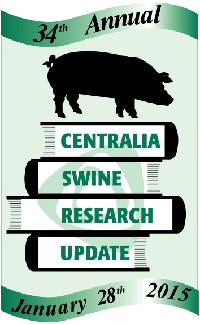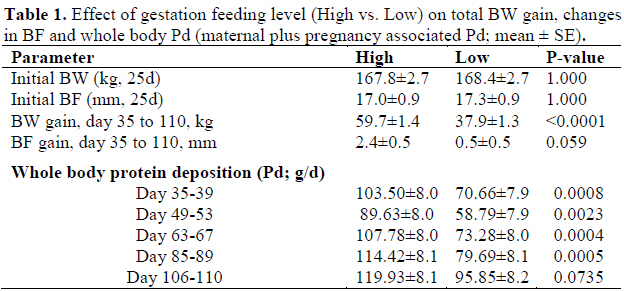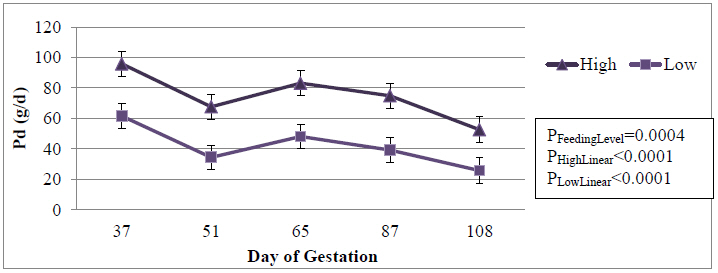



Dynamics of Nitrogen Retention in Gestating Sows: Implications for Feeding Programmes
Gaining a better understanding of protein deposition during pregnancy will help nutritionists to formulate better diets for sows and gilts during this period, C.F.M. de Lange of the University of Guelph told the 2015 Centralia Swine Research Update.
Introduction
Body protein deposition is a main determinant of amino acid and energy requirements of gestating sows.
However, based on the most recent review, empirical data on the dynamics of protein deposition in gestating sows is limited (NRC, 2012), especially as it relates to the gradual transition of maternal protein deposition in early gestation to foetal protein deposition in late gestation.
Particularly for parity 1 and 2 sows, where maternal protein deposition is relatively large and affected by energy intake, more data is needed.
Objectives
To assess the dynamics of protein deposition (nitrogen retention × 6.25) in gestating gilts and investigate the effect of energy intake on maternal protein deposition.
Methodology
Fifty-two gestating purebred Yorkshire gilts (initial bodyweight and P2 back fat at 25 days of gestation 168.1 ± 2.2kg and 17.1 ± 0.8mm) from the Arkell Swine Research Station were used for this trial, distributed over four groups. Based on average bodyweight and backfat at breeding and the NRC (2012) swine nutrient requirements modelling programme, high and low feeding levels corresponding to 15 per cent above and 15 per cent below estimated energy requirements for gestating gilts were determined (2.59 and 1.87kg per day, respectively).
A corn and soybean meal diet was used for both feeding levels (3.30Mcal ME per kg, 17.8 per cent crude protein, 0.82 per cent SID lysine) and fed from days 30 to 110 of gestation.
Throughout gestation, there were five nitrogen-balance periods of four days in length, starting at 35, 49, 63, 85 and 106 days of gestation. Urinary nitrogen was collected quantitatively via urinary catheters and fecal nitrogen was calculated from nitrogen intake and faecal digestibility; the latter was determined using an indigestible marker.
Bi-weekly, bodyweight and backfat were measured throughout gestation. To correct for systematic differences between nitrogen-balance observations and protein deposition, the NRC (2012) modelling programme was forced to be consistent with observed changes in bodyweight and backfat between days 39 and 110 of gestation.
The mean ratio between modelled protein deposition and observed nitrogen-balance was used to adjust nitrogen balance observations.
Pregnancy-associated protein deposition (foetus, mammary gland, uterus and placenta) was calculated using actual litter size and average piglet birth weight using NRC (2012). Maternal protein deposition was calculated as the difference between total protein deposition and pregnancy-associated protein deposition.
Results
At 25 days of gestation, bodyweight and bckfat did not differ between feeding levels (P=1.00), but at 110 days of gestation, feeding level had an effect on bodyweight (P<0.0001) and tended to affect backfat (P=0.059) (Table 1).

Feeding level and day of gestation affected whole body protein deposition (Table 1) and maternal protein deposition (Figure 1; (P<0.01) but there was no interaction (P>0.67).
Whole body protein deposition showed both linear and quadratic relationships with day of gestation (P<0.05).
Maternal protein deposition declined linearly (P<0.001) with day of gestation (Figure 1). Across the five nitrogen-balance periods, whole body and maternal protein deposition increased by 33.0 ± 1.6g per day as a result of the increased feed intake.

Conclusion and Implications
Increasing feed intake during gestation of parity 1 sows (gilts) leads to a substantial increase in whole body protein deposition, which is constant throughout gestation and consistent with NRC (2012).
However, the gradual decline in maternal protein deposition with day of gestation is in contrast to NRC (2012) and has important implications for the factorial estimation of amino acid requirements of gestating gilts.
Determining the pattern of whole body protein deposition in gestating sows allows nutritionists to more closely estimate the changing nutrient requirements during gestation and formulate rations accordingly.
Further investigation into the physiological control of the dynamic changes in maternal protein deposition throughout gestation is warranted.
Acknowledgments: Thanks to lab mates and technical staff. Financial support provided by Ontario Pork, Ontario Ministry of Agriculture and Food, de Heus, and Ajinomoto.
References
- NRC (National Research Council) 2012. Nutrient requirements of swine. National Academy Press, Washington, DC
Reference
Miller E.G., D.C. Wey, C.L. Levesque and C.F.M. de Lange. 2015. Dynamics of nitrogen retention in gestating sows: Implications for feeding programs. Proceedings of 34th Annual Centralia Swine Research Update. 28 January 2015. I13-I14.
June 2015








